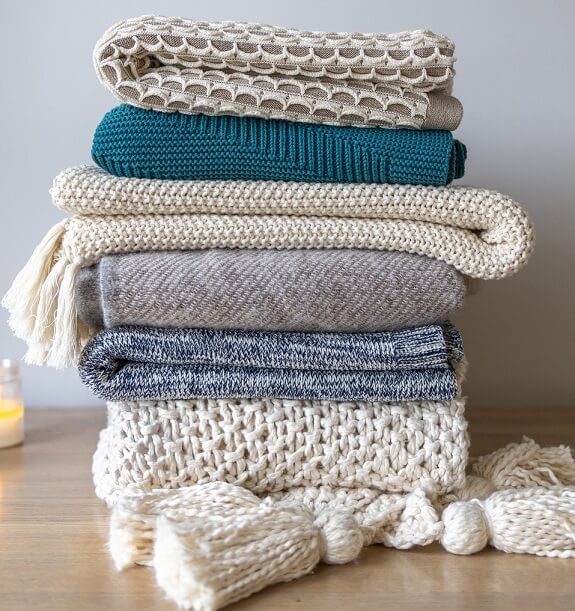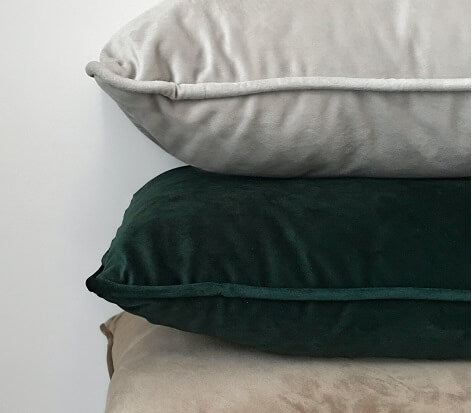
Thinking about grabbing a wool blanket just because it’s cheap? Hold on a minute. While those budget-friendly wool blankets might catch your eye, they often come with some sneaky downsides that can affect not only your comfort but also your health and wallet over time. In this article, we’ll take a closer look at why low-quality wool blankets might not be the best choice and what to look for to make sure you get a cozy, comfy blanket worth keeping.
Many people have experienced that annoying itch or scratchy feeling when wearing wool sweaters or snuggling under wool blankets. That itchy sensation is a pretty common complaint and usually comes down to the type of wool and how it’s processed. Some wool feels soft and gentle, while other types can be rough and irritating, especially if you have sensitive skin.
What’s So Special About Wool Blankets?
Wool blankets have been a go-to for cozy comfort and warmth for ages. Made from natural wool fibers, these blankets aren’t just warm—they’re great at regulating your body temperature, so they work well all year round. Whether you’re wrapping up on a chilly winter night or just want a light layer on a cool summer evening, a good-quality wool blanket can make a big difference. Instead of feeling coarse and scratchy, a quality blanket should feel soft and inviting. The secret lies in the quality of the wool fibers and how the blanket is cared for.
Different Types of Wool and What They Mean for You
Wool isn’t just wool—it comes from various animals like sheep, alpacas, and even camels, and the quality varies a lot. Fine wool, like merino wool, is known for being incredibly soft and gentle, perfect if you have sensitive skin. On the flip side, coarse wool has thicker, rougher fibers that can feel itchy and scratchy against bare skin. But don’t worry—there are ways to soften even the roughest wool. For example, adding half a cup of white vinegar to the rinse cycle when washing your wool blanket can help smooth out the fibers and reduce that prickly feeling. Choosing high-quality wool and taking good care of it means you’ll enjoy a blanket that’s warm, durable, and wonderfully soft.
When Wool Feels Itchy and Uncomfortable
One of the biggest downsides of cheap wool blankets is that they can be downright itchy. That’s because they’re often made from coarse, rough fibers instead of soft, premium wool. These thicker fibers don’t bend easily and can irritate your skin, much like an itchy sweater might. While some people can handle the scratchiness, many find it uncomfortable—especially when trying to get a good night’s sleep.
Itchy wool blankets can also cause skin irritation, especially if you have sensitive skin. Poorly processed or thick fibers in cheap blankets tend to be the culprits behind this discomfort. Long exposure to these rough fibers can lead to redness, rashes, or even hives, making it tough to rest well. Even wool hats can cause irritation if the wool is too coarse or the hat is too warm for the weather.
Instead of settling for itchy discomfort, it’s worth investing in a high-quality blanket designed to be soft and gentle. Your skin—and your sleep—will thank you.
Why Cheap Wool Blankets Aren’t Worth It
1. They Don’t Last Long

Cheap wool blankets might seem like a steal at first, but they usually don’t hold up well. To cut costs, manufacturers often use lower-quality wool and skimp on stitching, which means your blanket could start fraying, thinning, or even developing holes after just a few uses. Coarse fibers break down faster, so the blanket loses its warmth and comfort quickly.
On the other hand, a high-quality wool blanket is made to last. With stronger fibers and better craftsmanship, these blankets stay cozy and durable for years, saving you money in the long run. Plus, premium blankets tend to feel smoother and shed less over time.
2. They May Contain Harmful Chemicals
Some cheap wool blankets are made with synthetic materials and treated with harsh chemicals that can be harmful. Flame retardants and certain dyes might release toxic fumes when heated, which can be dangerous, especially around children or pets. These chemicals can also worsen wool allergies or sensitivities, causing skin reactions.
Additionally, chemical treatments can make wool fibers rougher and more irritating. Loose fibers from these blankets might also aggravate asthma or allergies. To stay safe, look for blankets from trusted brands that use natural materials and avoid harmful additives. Always check labels carefully before buying.
3. They Might Not Keep You Warm
The whole point of a wool blanket is to keep you warm, right? Unfortunately, cheap wool blankets often fall short. When manufacturers mix wool with synthetic fibers or use inferior fleece, the blanket loses its natural ability to insulate. Even if it looks thick, it might not trap heat well, leaving you cold on chilly nights.
This means you might end up piling on extra blankets or cranking the heat, which defeats the purpose and can bump up your energy bills. Investing in a quality wool blanket means better warmth and temperature control without the extra layers or costs. If you’re still feeling chilly, flannel sheets can be a cozy alternative.
Health Concerns with Cheap Wool Blankets
Cheap wool blankets can cause more than just itchiness—they might pose real health risks, especially if you have sensitive skin or allergies. Coarse fibers and harsh chemicals can lead to skin irritation, redness, and itching.
Some people react to lanolin, a natural wax found on wool fibers, which can cause redness, swelling, and discomfort. Plus, fibers and chemicals released into the air can trigger respiratory issues like asthma or allergic rhinitis.
If you have skin conditions like eczema or dermatitis, exposure to these irritants can make things worse. That’s why choosing high-quality, natural, breathable, and hypoallergenic wool blankets is so important. Merino wool blankets are a great choice—they’re soft, hypoallergenic, and gentle on the skin. Alpaca wool is another excellent option, offering softness and durability with less chance of irritation.
Wool Allergies and Sensitivities Explained
True wool allergies are pretty rare, but some folks do experience irritation from lanolin or the roughness of coarse wool. If you’re sensitive, you might notice redness or itching after contact with certain wool items. The good news? Not all wool is the same. High-quality wool, like merino, is finer and less likely to irritate, making it better for sensitive skin. Plus, washing wool with hair conditioner or other softening treatments can make a big difference in comfort. With the right wool and care, you can enjoy the warmth and coziness without the itch.
The Environmental Side of Wool Production
Wool production impacts the environment, and it’s worth thinking about when you shop. Unsustainable sheep farming contributes to greenhouse gas emissions, water pollution, and land degradation. Methane and nitrous oxide from sheep are potent greenhouse gases that speed up climate change.
Chemicals and fertilizers used in sheep farming can pollute waterways, harming wildlife and people. Overgrazing can lead to soil erosion and loss of biodiversity, making the land less healthy over time. Wool farming also uses lots of water, feed, and energy, which adds to environmental strain.
To lessen these impacts, choose wool products labeled as sustainable, eco-friendly, or regenerative. Look for blankets made from recycled or upcycled wool to reduce waste. By making thoughtful choices, you can enjoy wool’s benefits while supporting a healthier planet.
How to Soften Wool Blankets and Make Them Less Itchy
If your wool blanket feels scratchy, don’t give up on it yet. There are easy ways to soften those fibers and make your blanket cozy again. Start by washing it in cold water with a mild detergent made for wool fabrics. Adding half a cup of white vinegar to the rinse cycle can help smooth the fibers and reduce itchiness.
For extra softness, soak your blanket in a mix of water and hair conditioner for 15-20 minutes before rinsing well. Always air dry your blanket to keep it soft and prevent shrinkage. Regular gentle care keeps wool fibers flexible and cozy, turning even the itchiest blanket into a comforting companion.
Caring for Your Wool Blanket
Taking good care of your wool blanket means it will stay soft, warm, and in great shape for years. Always wash it in cold water with gentle detergent, and avoid harsh chemicals that can damage the fibers. Air drying your blanket outside in fresh air is best—skip the dryer to prevent shrinking and stiffness.
Regular airing helps keep your blanket smelling fresh and feeling light. When you’re not using it, store your blanket in a cool, dry place to protect it from moisture and pests. Whether you wear wool sweaters or snuggle under a wool blanket, softening the fibers and proper care make all the difference. With a little attention, your wool blanket will be a cozy part of your sleep environment, offering ultimate comfort year after year.
Choose Quality Over Cheapness
It’s tempting to buy a cheap wool blanket, but the hidden costs—itchiness, poor durability, health risks, and lack of warmth—aren’t worth it. Just like a good wool sweater, a premium wool blanket offers superior comfort and longevity. When shopping, look for natural fibers, trusted brands, and expert craftsmanship. Luxury options like cashmere blankets, wool coats, fleece blankets, and soft bed accessories like wool socks provide exceptional softness and warmth, perfect for sensitive skin and cozy comfort.
Your sleep and well-being are worth the investment. Choose quality, and enjoy the cozy warmth and softness that only a great wool blanket can offer. For those interested in other ways to improve sleep quality, weighted blankets may be worth exploring.






